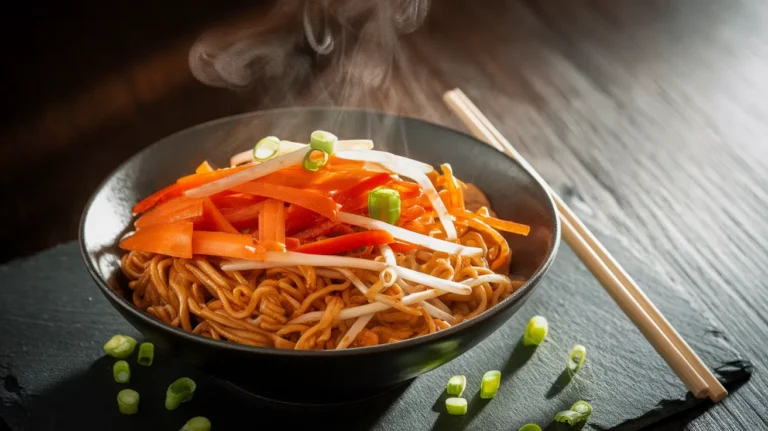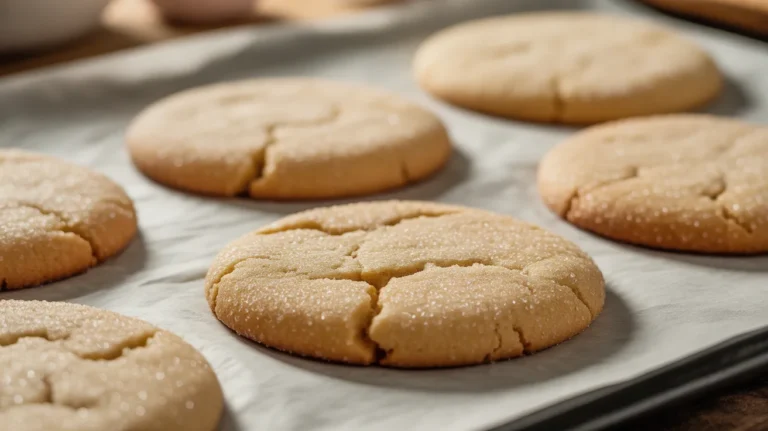These incredibly fluffy vegan donut holes are the perfect treat for anyone new to plant-based baking. Our foolproof vegan donut holes recipe walks you through every single step, ensuring golden, tender bites that taste just like traditional donuts but without any animal products.
SERVES: 4 | PREP: 20 MIN | COOK: 25 MIN | TOTAL: 45 MIN
Ingredients for Perfect Vegan Donut Holes
Dry Ingredients
| Ingredient | Amount | Purpose |
|---|---|---|
| All-purpose flour | 2 cups | Creates structure |
| Granulated sugar | ½ cup | Adds sweetness and tenderness |
| Baking powder | 2 teaspoons | Makes them fluffy |
| Salt | ½ teaspoon | Enhances all flavors |
| Ground nutmeg | ¼ teaspoon | Classic donut spice |
| Ground cinnamon | ½ teaspoon | Warm, cozy flavor |
Wet Ingredients
| Ingredient | Amount | Purpose |
|---|---|---|
| Unsweetened almond milk | ¾ cup | Liquid base (room temperature) |
| Melted vegan butter | 3 tablespoons | Richness and tenderness |
| Vanilla extract | 1 teaspoon | Sweet aroma |
| Apple cider vinegar | 1 teaspoon | Reacts with baking powder |
For Coating Your Vegan Donut Holes
| Ingredient | Amount |
|---|---|
| Powdered sugar | 1 cup |
| Ground cinnamon | 1 tablespoon |
Complete Step-by-Step Vegan Donut Holes Instructions
Phase 1: Setting Up Your Kitchen (8 minutes)
Step 1: Prepare Your Oil Station Pour 4 cups of neutral oil (vegetable, canola, or peanut) into a heavy-bottomed pot that’s at least 4 inches deep. The oil should be 3 inches deep – this prevents overflow when you add the donut holes. Attach your candy thermometer to the side of the pot, making sure the tip doesn’t touch the bottom. Turn heat to medium and begin heating – this will take about 8 minutes to reach 350°F.
Step 2: Create Your Draining Station Line two large plates with 3-4 layers of paper towels each. Place them near your stove but not directly next to the hot oil for safety. Get your slotted spoon ready – this will be your best friend for safely moving the donut holes.
Step 3: Set Up Your Coating Station In a medium bowl, whisk together the powdered sugar and 1 tablespoon of cinnamon until completely combined. No lumps should remain. Place this bowl next to your draining plates so you can coat the donut holes while they’re still warm.
Phase 2: Making the Perfect Batter (10 minutes)
Step 4: Measure and Mix Dry Ingredients In your largest mixing bowl, add the flour first, then the sugar, baking powder, salt, nutmeg, and cinnamon. Use a wire whisk to mix everything together for 30 seconds. Make sure you can’t see any streaks of baking powder – this ensures even rising. Create a deep well in the center using a large spoon, pushing the flour mixture up the sides of the bowl.
Step 5: Prepare the Wet Ingredients In a medium bowl, pour the room-temperature almond milk first. Add the melted vegan butter (let it cool for 2 minutes after melting so it doesn’t cook the other ingredients). Add vanilla extract and apple cider vinegar last. The mixture will look slightly curdled when you add the vinegar – this is exactly what we want! Whisk gently for 15 seconds until just combined.
Step 6: Combine Wet and Dry (The Critical Step) Pour ALL of the wet ingredients into the well you created in the dry ingredients. Using a wooden spoon or rubber spatula, start from the center and fold the mixture together. Use a gentle folding motion, not stirring circles. Stop the moment you can’t see dry flour streaks – the batter should look lumpy and slightly rough. This should take exactly 12-15 folds. Overmixing will make tough, dense donut holes.
Phase 3: Shaping Your Vegan Donut Holes (12 minutes)
Step 7: Portion the Batter Using a small cookie scoop (1½ tablespoons) or two teaspoons, scoop portions of batter. Each portion should be about the size of a large marble – roughly 1 inch across. Don’t worry about perfect round shapes; slightly irregular donut holes actually look more homemade and charming.
Step 8: Shape on Parchment Place each scooped portion on a parchment-lined baking sheet, leaving space between each one. You should get approximately 20-24 donut holes total. If any portions look much larger or smaller than the others, use your spoons to adjust – uniform sizing helps them cook evenly.
Step 9: Check Your Oil Temperature Your oil should now be at 350°F. If it’s not quite there, wait – patience now prevents greasy donut holes later. Test the temperature by dropping a small piece of batter into the oil. It should immediately sizzle and float to the surface within 5 seconds.
Phase 4: Frying Your Vegan Donut Holes (15 minutes)
Step 10: First Batch Technique Using your slotted spoon, carefully lower 4-5 donut holes into the hot oil. Don’t drop them from high up – lower them close to the oil surface to prevent splashing. They should start bubbling immediately around the edges and float within 10 seconds.
Step 11: Monitor and Turn Let them fry for exactly 90 seconds without touching them. Watch for the bottom half to turn golden brown – you’ll see this color creeping up the sides. Using your slotted spoon, gently turn each donut hole over. They should flip easily when ready.
Step 12: Complete the First Side Fry the second side for another 60-90 seconds until deep golden brown all over. The total frying time should be 2½-3 minutes per batch. They should have puffed up to nearly double their original size and sound hollow when tapped with the spoon.
Step 13: Perfect Draining Technique Lift each donut hole with the slotted spoon, letting excess oil drip back into the pot for 3 seconds. Transfer to your paper towel-lined plate and let drain for exactly 30 seconds – no longer or they’ll get soggy.
Step 14: Immediate Coating While the donut holes are still warm (this is crucial!), roll each one in your cinnamon-sugar mixture. The residual heat helps the coating stick beautifully. Use a clean spoon to roll them around until completely coated.
Step 15: Continue Batching Let the oil temperature return to exactly 350°F before adding your next batch – this usually takes 60-90 seconds. Repeat steps 10-14 until all donut holes are fried and coated.
Phase 5: Final Steps (5 minutes)
Step 16: Cool and Serve Let the coated donut holes cool on a clean plate for 2-3 minutes before serving. This lets the coating set and prevents burning your mouth on the hot centers.
Chef’s Notes for Vegan Donut Holes Success
• Oil temperature is everything: Use a proper candy thermometer and maintain 350°F. Too hot burns the outside before cooking through; too cool creates greasy, heavy donut holes.
• Don’t overmix the batter: The lumpy, rough texture you see after folding is perfect. Smooth batter means you’ve overmixed and will get tough vegan donut holes.
• Size matters for even cooking: Keep donut holes roughly the same size so they all finish cooking at the same time.
• Serve immediately: These vegan donut holes are absolutely best within 2 hours of frying when they’re still slightly warm and the coating is fresh.
Nutrition Per Serving (6 donut holes)
Calories: 285 | Protein: 4g | Carbs: 52g | Fat: 8g
Creative Vegan Donut Holes Variations
Double Chocolate Vegan Donut Holes
Replace ¼ cup flour with cocoa powder and dip cooled donut holes in melted dark chocolate mixed with 2 tablespoons coconut oil. Let set for 10 minutes before serving.
Glazed Lemon Vegan Donut Holes
Mix 1 cup powdered sugar with 3 tablespoons fresh lemon juice and 1 teaspoon lemon zest for a bright glaze that pairs beautifully with the cinnamon base.
Maple Spice Version
Replace regular sugar coating with maple sugar and extra cinnamon. The warm spices complement maple flavor perfectly, similar to our vegan oatmeal cookies.
Festive Pink Donut Holes
Add natural strawberry powder to your coating for pretty pink donut holes, perfect for special occasions alongside red velvet treats.
Storage & Reheating Your Vegan Donut Holes
Room Temperature: Store in an airtight container for up to 2 days. Place parchment paper between layers to prevent the coating from getting sticky.
Freezing: Freeze uncoated donut holes in freezer bags for up to 3 months. Thaw completely at room temperature before coating and serving.
Reheating: Warm leftover donut holes in a 300°F oven for 3-4 minutes to restore crispness. Never microwave as this creates chewy, tough textures.

Troubleshooting Common Vegan Donut Holes Problems
Problem: My donut holes are greasy and heavy Solution: Your oil temperature was too low. Always use a thermometer and maintain exactly 350°F. Let oil reheat between batches.
Problem: Dense, tough texture instead of fluffy Solution: You overmixed the batter. Next time, fold ingredients just until you can’t see dry flour – lumpy is perfect!
Problem: Burnt outside but raw, doughy inside Solution: Oil was too hot. Lower temperature to 340°F and cook slightly longer, about 4 minutes total per batch.
Problem: Coating won’t stick to my donut holes Solution: Roll them in the sugar mixture while they’re still warm from frying. Cold donut holes won’t hold coating well.
Problem: Batter is too thick to scoop easily Solution: Add almond milk 1 tablespoon at a time until the batter drops easily from a spoon but isn’t runny.
Essential Equipment for Making Vegan Donut Holes
• Heavy-bottomed pot (at least 4 inches deep) • Candy thermometer (crucial for success) • Small cookie scoop or two teaspoons • Long-handled slotted spoon • Paper towels for draining • Large mixing bowls (at least 2) • Wire whisk • Parchment paper
Complete Shopping List
Baking Aisle
- All-purpose flour (2 lb bag)
- Granulated sugar
- Powdered sugar
- Baking powder (check expiration date)
- Ground cinnamon
- Ground nutmeg
- Pure vanilla extract
Refrigerated Section
- Vegan butter (stick form works best)
- Unsweetened almond milk
Pantry & Oil Section
- Fine sea salt
- Apple cider vinegar
- Neutral frying oil (vegetable, canola, or peanut)
Top 5 Success Secrets for Perfect Vegan Donut Holes
1. Cut open your first donut hole to check doneness – the center should be fluffy and cooked through with no wet, sticky batter remaining.
2. Maintain a steady frying rhythm: while one batch cooks, have your next batch ready to go. This keeps your oil temperature consistent.
3. Make extra cinnamon-sugar coating – you’ll want to give some donut holes a second roll for extra sweetness, and you might snack on the leftover mixture!
4. Keep a splatter screen handy when frying to protect yourself from oil pops while still being able to monitor the donut holes.
5. Let your oil cool completely before cleaning up – never pour hot oil down the drain. Let it solidify and dispose of it in the trash.




